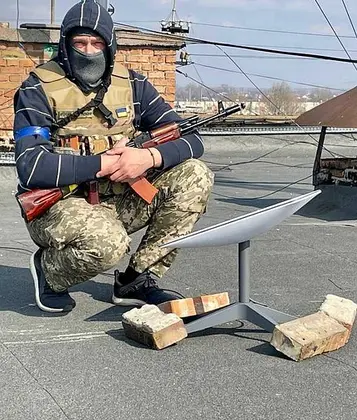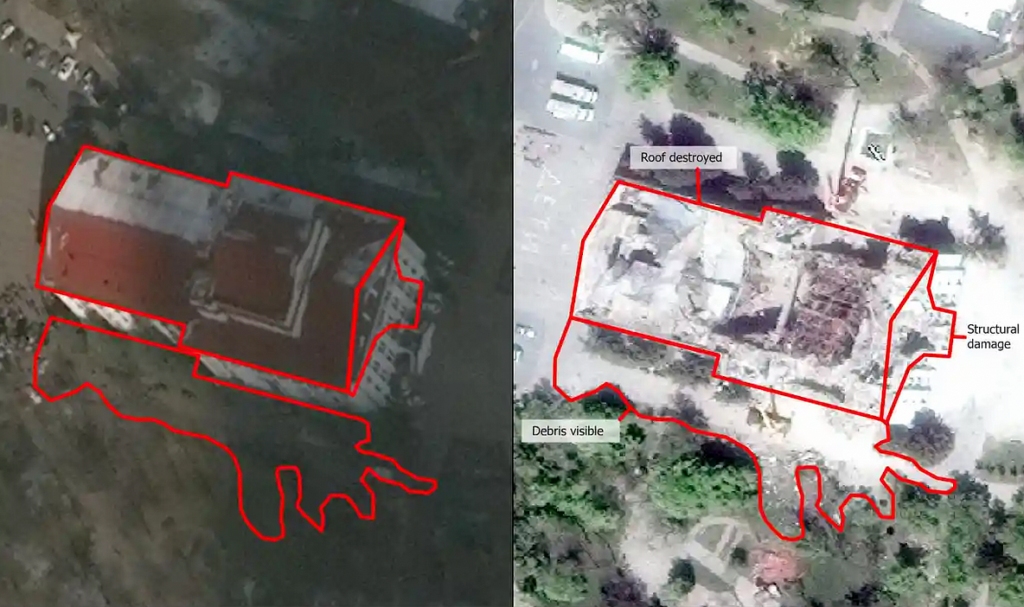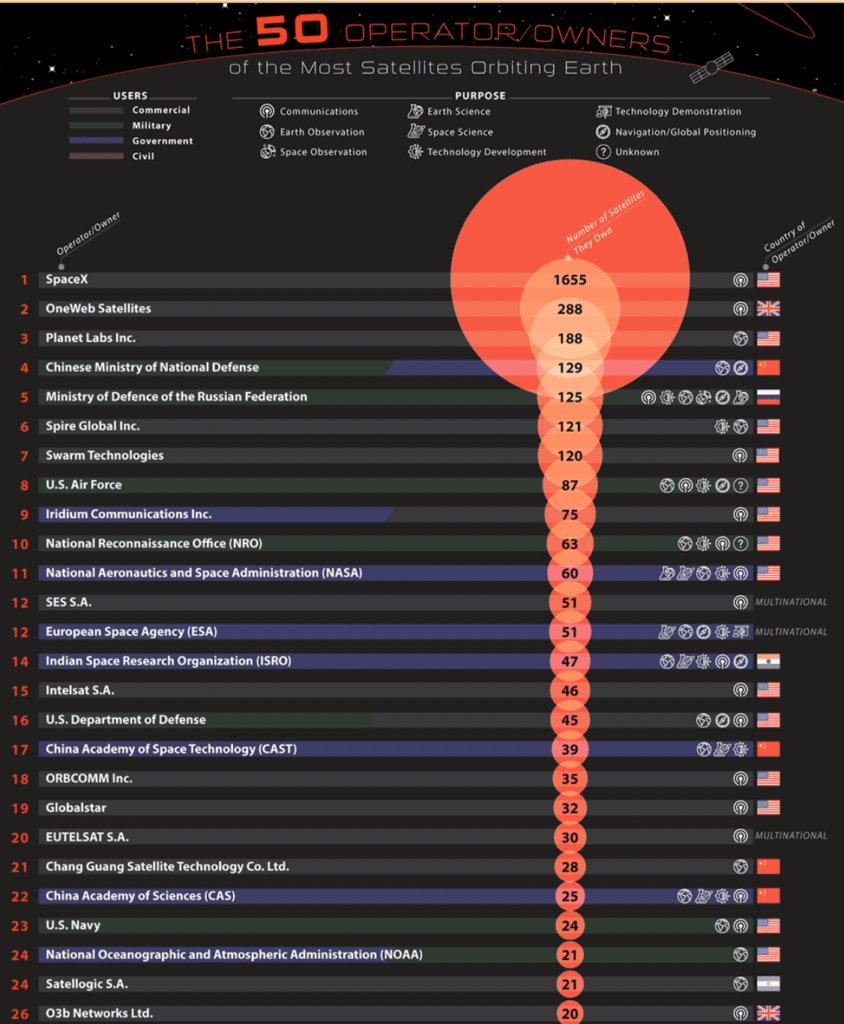Oct. 31, 2022
Russia tried to destroy Ukraine’s internet access at the outset of the war until Kyiv’s IT experts did a workaround by linking to Elon Musk’s Starlink satellite system, the largest in the world. Today, thousands of his satellite dishes, or “transceivers”, are scattered across Ukraine and provide telecommunications for citizens, hospitals, governments, and its military.
JOIN US ON TELEGRAM
Follow our coverage of the war on the @Kyivpost_official.
Starlink is owned and operated by Musk’s private rocket ship company SpaceX, which offers satellite coverage in 40 countries. But on Oct. 27, Russia threatened to target these and other “quasi-commercial” satellites because they are helping Ukraine’s war efforts. The United States responded that any satellite attacks would result in counterattacks.
This month, Putin’s war has spread into outer space.
Most people don’t realize how commercialized and weaponized space has become or that it is about to become a battlefield. Both Russia and the United States have significant offensive capability in the sky, as does China, and dozens more nations (see chart below). Each satellite – whether used for commercial, military, or scientific purposes – is essentially an unmanned space station, loaded with technology that orbits the earth to perform specific tasks.
As of spring 2022, there were almost 5,500 active satellites in orbit, and estimates are that another 58,000 will be launched by 2030. The vast majority operate 350 miles above the Earth and are used for science, earth science, or telecommunications purposes. But there are also dozens of military satellites that operate at higher altitudes, providing surveillance, navigation, reconnaissance, and communications support to armed forces and navies around the world.

ISW Russian Offensive Campaign Assessment, January 21, 2025
But this month Russia became the first nation in history to threaten “Star Wars” — a message delivered by Putin’s sidekick, former President/Prime Minister Dmitry Medvedev. He tweeted – ironically the day after Elon Musk became owner of Twitter – his congratulations to Musk for completing his $44 billion Twitter takeover, but also said Musk must stop helping Ukraine.

But a full-throated military threat against Starlink was issued before the United Nations by Konstantin Vorontsov, deputy director of the Russian foreign ministry’s department for non-proliferation and arms control. He stated that the U.S. and its allies were trying to use space to enforce Western dominance and that satellites to aid Ukraine were “an extremely dangerous trend” and “provocative”. He didn’t name SpaceX or Starlink, but raised the issue of international principles and treaties. “At the very least, this provocative use of civilian satellites is questionable under the Outer Space Treaty which provides for the exclusively peaceful use of outer space, and must be strongly condemned by the international community.”
Naturally, Washington immediately responded to the Russian threat. For years, the U.S. and its allies have relied on imaging technology provided by U.S. companies such as Planet Technologies and Maxar Technologies. They gather real-time, high-resolution images of war zones, weaponry or troop movements, and terrain.
“I am certain that my counterpart in Russia, whoever that is, is not very happy with Starlink, as it’s assisting Ukraine,” said Lt. Gen. John Shaw, deputy commander of the U.S. Space Force. (The Force is a separate and distinct branch of the armed services, organized under the Department of the Air Force.) He added: “With commercial imagery, such as Maxar’s products, that are plastering all over the world news about the things that are going on, I don’t think they’re very happy about that either. And we know that they’re probably going to take steps to try to stop those commercial services because they run counter to Russia’s national interest.”
White House Press Secretary Karine Jean-Pierre took a tougher and more pointed stance. “Any attack on U.S. infrastructure will be met with a response, as you’ve heard from my [Pentagon] colleague, in a time and manner of our choosing. And that still stands. We will pursue all means to explore, deter, and hold Russia accountable for any such attacks. Clearly, I’m not going to lay them down here … in public. But we have made ourselves very clear.”
Besides commercial satellites, there are sophisticated military space stations operating at higher altitudes. The U.S. has 123, Russia has 74, China 68, India, Britain, and Germany each have seven and France and Israel one apiece. All Western allies rely mostly on American military satellite intelligence and imaging. Moscow has already mounted attacks in space by disrupting satellites and repeatedly trying to jam the Starlink system during the war, without success. To date no nation has destroyed another’s satellite.
But in November 2021, just before the invasion, Putin’s armed forces demonstrated such capability by destroying one of their own satellites with an anti-satellite missile. The target had been in orbit since 1982 and had disintegrated into 1,500 pieces in low orbit that posed a hazard to other space operations. (In 2007, China and the U.S. both destroyed small satellites to clean up their orbital debris.) But Russia’s attack, staged before its invasion of Ukraine, was clearly a warning signal to the U.S. and others. Its demolition was aggressive, and resulted in wreckage hitting the International Space Station in a nearby orbit, threatening its crew of two Russians, a German, and four Americans.
American officials criticized the incident. A U.S. State Department official said at the time that “Russia’s dangerous and irresponsible behavior jeopardizes the long-term sustainability of outer space and clearly demonstrates that Russia’s claims of opposing the weaponization of space are disingenuous and hypocritical.” Then General James Dickinson, U.S. Space Command Chief, commented that “Russia is developing and deploying capabilities to actively deny access to and use of space by the U.S. and its allies and partners.”
Weaponization in space steadily accelerates. Recent claims are that China is doing research on developing anti-satellite nuclear weapons, as is Russia. But the U.S. Space Force has more vigorously expanded its reach and arsenal with its Advanced Extremely High Frequency satellites (linked to allied military forces) that insure communication with allies in the event of a nuclear attack and to orchestrate a military response from space. These stations are resistant to electronic jamming and are capable of destroying enemy satellites. Depressingly, this is nicknamed the “doomsday connection”.
For these and other reasons, it’s unlikely that Star Wars will break out any time soon. Deterrents work, as does diplomacy. But it was disturbing, and not coincidental, that before Russia publicly threatened to destroy Starlink satellites, the erratic Musk, a one-man loose cannon at the center of space development, tweeted out Russian talking points that Ukraine should surrender Crimea and become a neutral nation to stop the fighting. He was severely drubbed by the West and media, walked back the remarks, and pledged to continue to donate Starlink technology to Ukraine. This is undoubtedly because his satellites are protected by the Pentagon.
Fortunately, the Americans appear to also have enormous superiority in space.
Reprinted with the author’s permission.
Diane Francis Newsletter on America and the World
30-day free trial at https://dianefrancis.substack.com/about
The views expressed in this opinion article are the author’s and not necessarily those of Kyiv Post.
You can also highlight the text and press Ctrl + Enter












